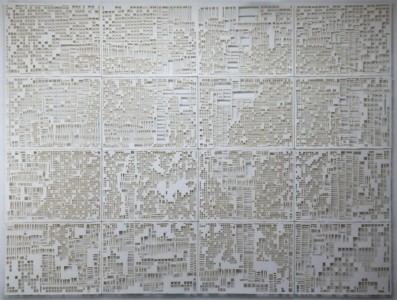Data becomes physical: data --> art --> 3D printing
/Very soon, all the data about us will be easily and invisibly tracked via sensors in our clothes and little patches we stick on our skin. The data will be privately ours. But then WHAT? You’ve got to have a way to extrapolate, summarize, compare and deliver a quick portrait of how you’re doing and what it means. Big data is meaningless if it can’t give me a picture that’s compelling and something I want to spend time with. A quick glance at pixilated graphics and status measurements is not enough.

I think pattern is the answer. Physical pattern. A language of pattern that’s readable to convey a sense of rhythm and proportions that are the compilation you. Complex, yet understandable, definitely recognizable.
Human in feel, hand-built libraries will rely on physical materials produced with wall size laser cutters and 3D printers on invisible x/y axes mounted on the ceiling. Digital tools produce sculptural texture and visual pattern quickly, easily, disposably. Renewed, updated, and recycled. In the spaces we live and work. For ourselves, households and teams of people who work together.
Responding to your stress level, mood, travels, sleep rhythms, nutrition level, body movement, posture, body strength, inflammation, calorie expenditure, productivity, financial ups/downs, word patterns…more than is listable here.
Encoded patterned language – visual and beautiful, steps ahead of data visualization, with complex models and algorithms to capture and convey the experience surrounding the data. Ambient, sensing walls that feel like ART, but deliver a narrative, patterned language that is reinforcing, probably anticipating, but definitely responding to all the data collected about you.
Will it kill the mystery of being human, simply magnify our defects or use sensors and a mass of measurements to acknowledge and present patterns of data that lure you into something beautiful and strangely compelling?
Stop thinking like scientists and start thinking like artists. Data meets art…meets 3D printing.



